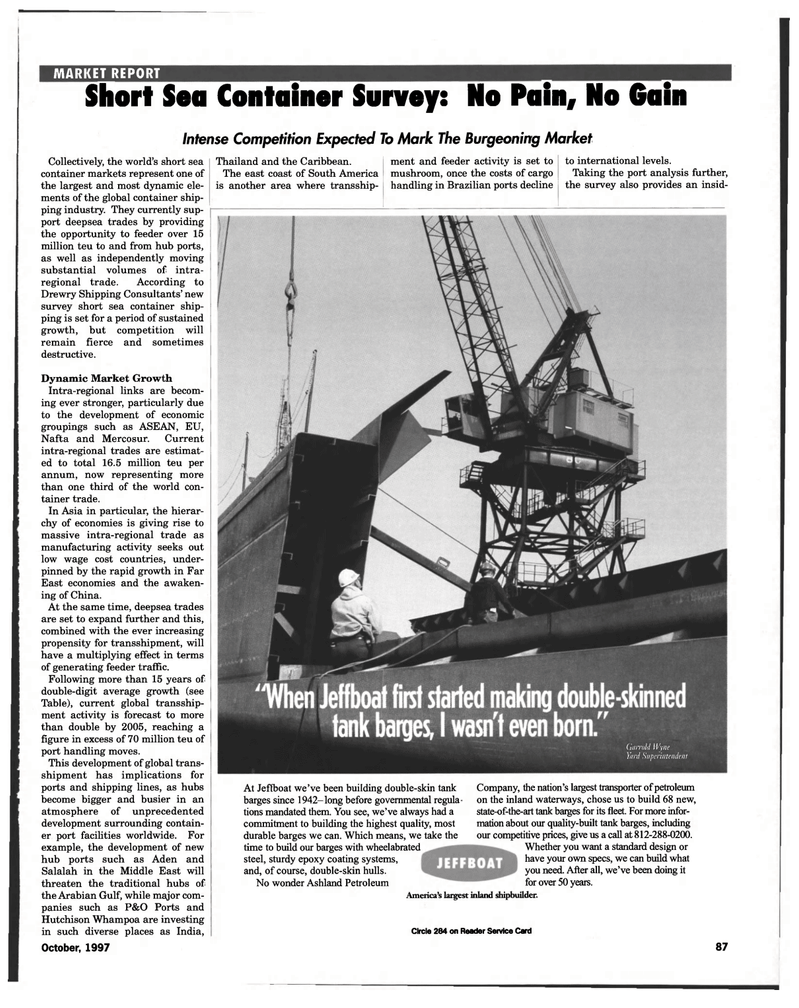
Page 77: of Maritime Reporter Magazine (October 1997)
Read this page in Pdf, Flash or Html5 edition of October 1997 Maritime Reporter Magazine
MARKET REPORT Short Sea Container Survey: No Pain, No Gain
Intense Competition Expected To Mark The Burgeoning Market
Collectively, the world's short sea container markets represent one of the largest and most dynamic ele- ments of the global container ship- ping industry. They currently sup- port deepsea trades by providing the opportunity to feeder over 15 million teu to and from hub ports, as well as independently moving substantial volumes of intra- regional trade. According to
Drewry Shipping Consultants' new survey short sea container ship- ping is set for a period of sustained growth, but competition will remain fierce and sometimes destructive.
Dynamic Market Growth
Intra-regional links are becom- ing ever stronger, particularly due to the development of economic groupings such as ASEAN, EU,
Nafta and Mercosur. Current intra-regional trades are estimat- ed to total 16.5 million teu per annum, now representing more than one third of the world con- tainer trade.
In Asia in particular, the hierar- chy of economies is giving rise to massive intra-regional trade as manufacturing activity seeks out low wage cost countries, under- pinned by the rapid growth in Far
East economies and the awaken- ing of China.
At the same time, deepsea trades are set to expand further and this, combined with the ever increasing propensity for transshipment, will have a multiplying effect in terms of generating feeder traffic.
Following more than 15 years of double-digit average growth (see
Table), current global transship- ment activity is forecast to more than double by 2005, reaching a figure in excess of 70 million teu of port handling moves.
This development of global trans- shipment has implications for ports and shipping lines, as hubs become bigger and busier in an atmosphere of unprecedented development surrounding contain- er port facilities worldwide. For example, the development of new hub ports such as Aden and
Salalah in the Middle East will threaten the traditional hubs of the Arabian Gulf, while major com- panies such as P&O Ports and
Hutchison Whampoa are investing in such diverse places as India,
Thailand and the Caribbean.
The east coast of South America is another area where transship- ment and feeder activity is set to mushroom, once the costs of cargo handling in Brazilian ports decline to international levels.
Taking the port analysis further, the survey also provides an insid-
At Jeffboat we've been building double-skin tank barges since 1942-long before governmental regula tions mandated them. You see, we've always had a commitment to building the highest quality, most durable barges we can. Which means, we take the time to build our barges with wheelabrated steel, sturdy epoxy coating systems, and, of course, double-skin hulls.
No wonder Ashland Petroleum
Company, the nation's latest transporter of petroleum on the inland waterways, chose us to build 68 new, state-of-the-art tank barges for its fleet. For more infor- mation about our quality-built tank barges, including our competitive prices, give us a call at 812-288-0200.
Whether you want a standard design or have your own specs, we can build what you need. After all, we've been doing it for over 50 years.
America's largest inland shipbuilder.
Circle 284 on Reader Service Card
G'timid Wyne
Yard Superintendent
October, 1997 87

 76
76

 78
78
